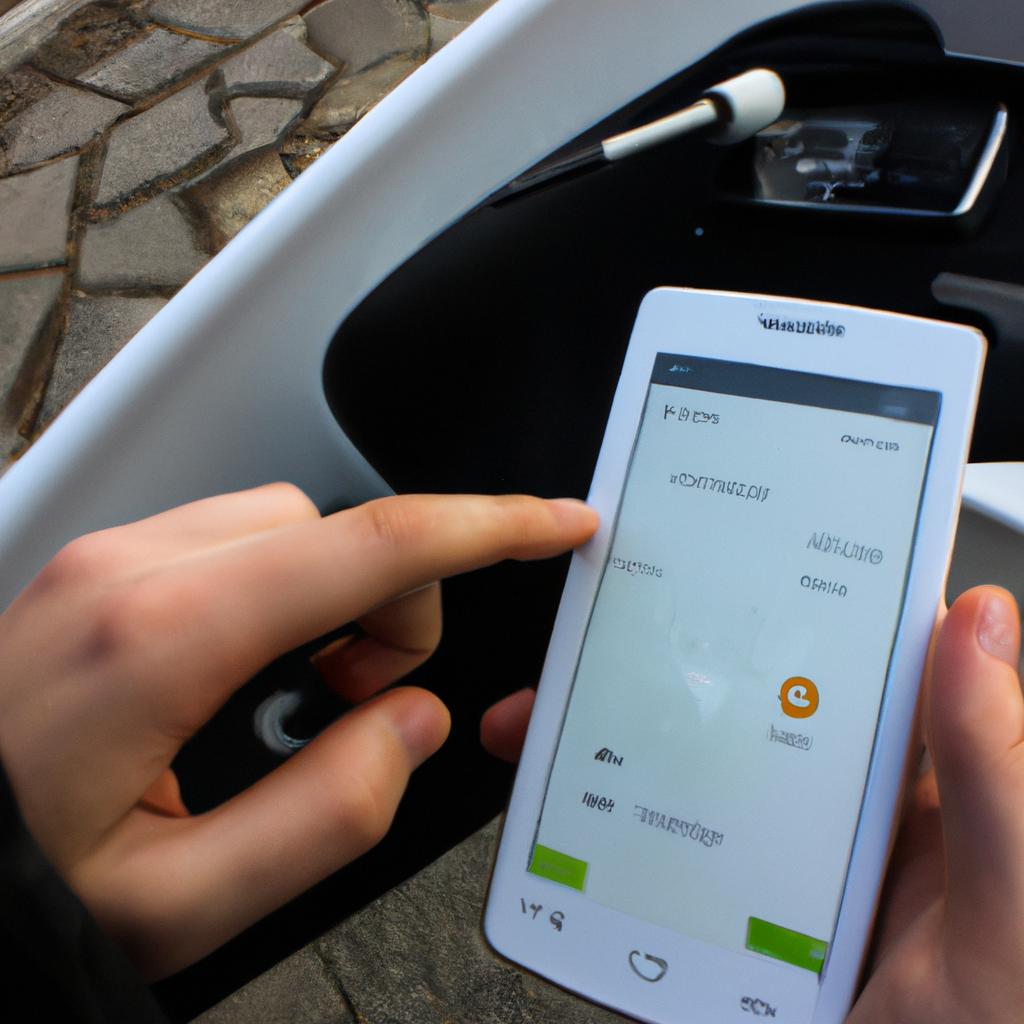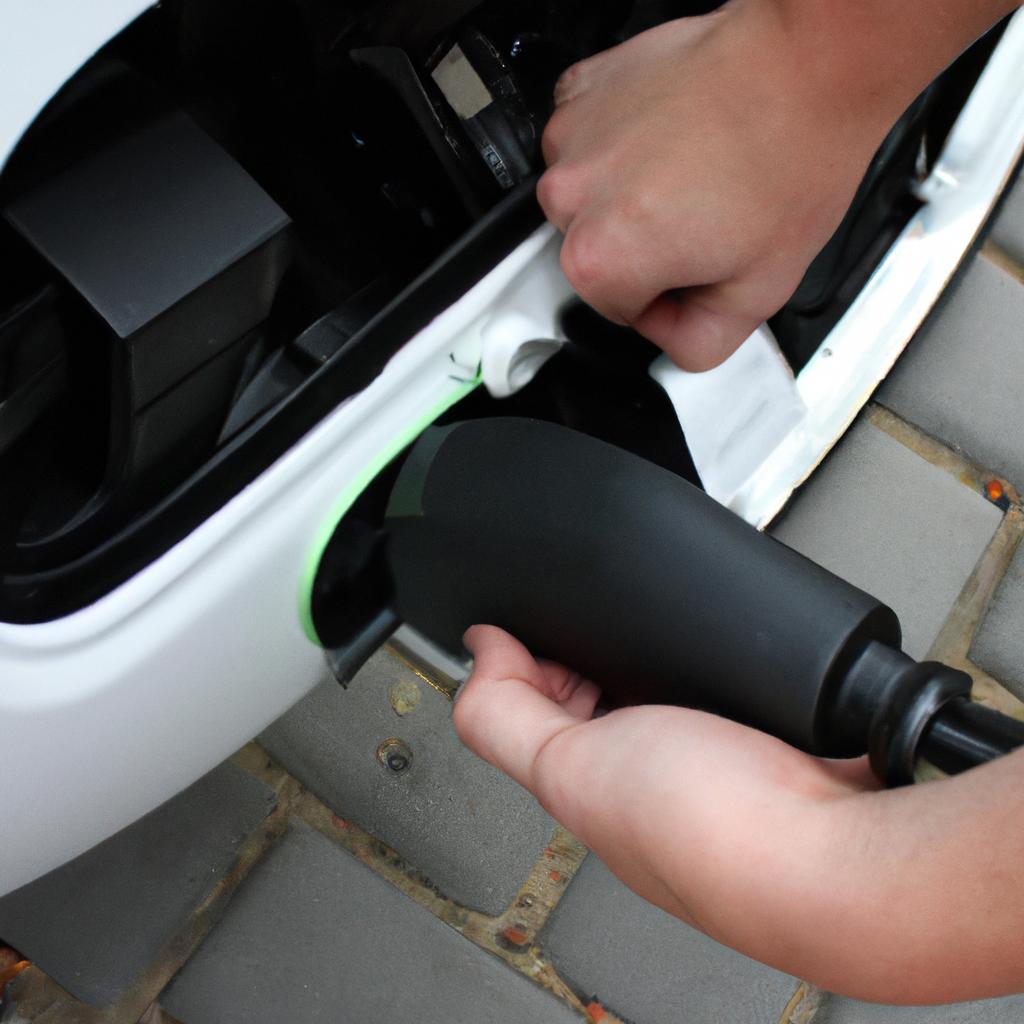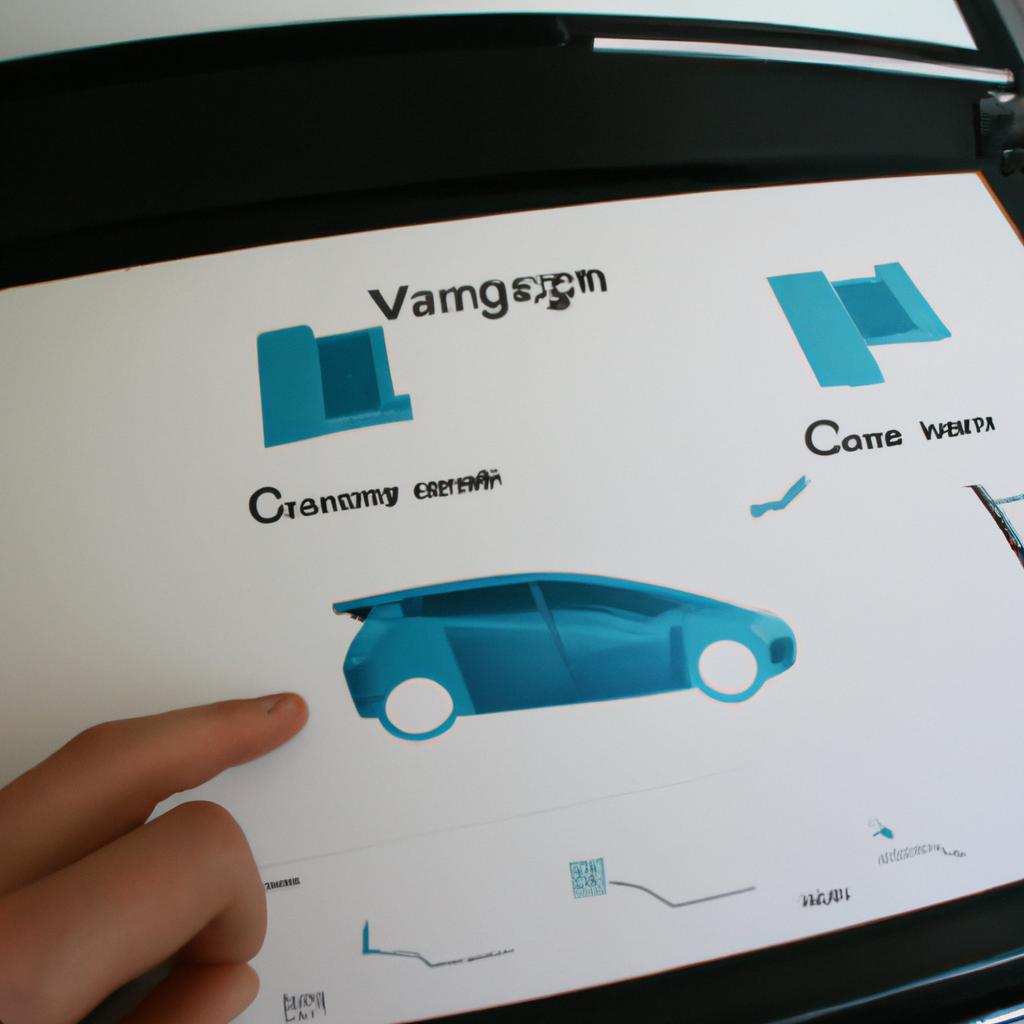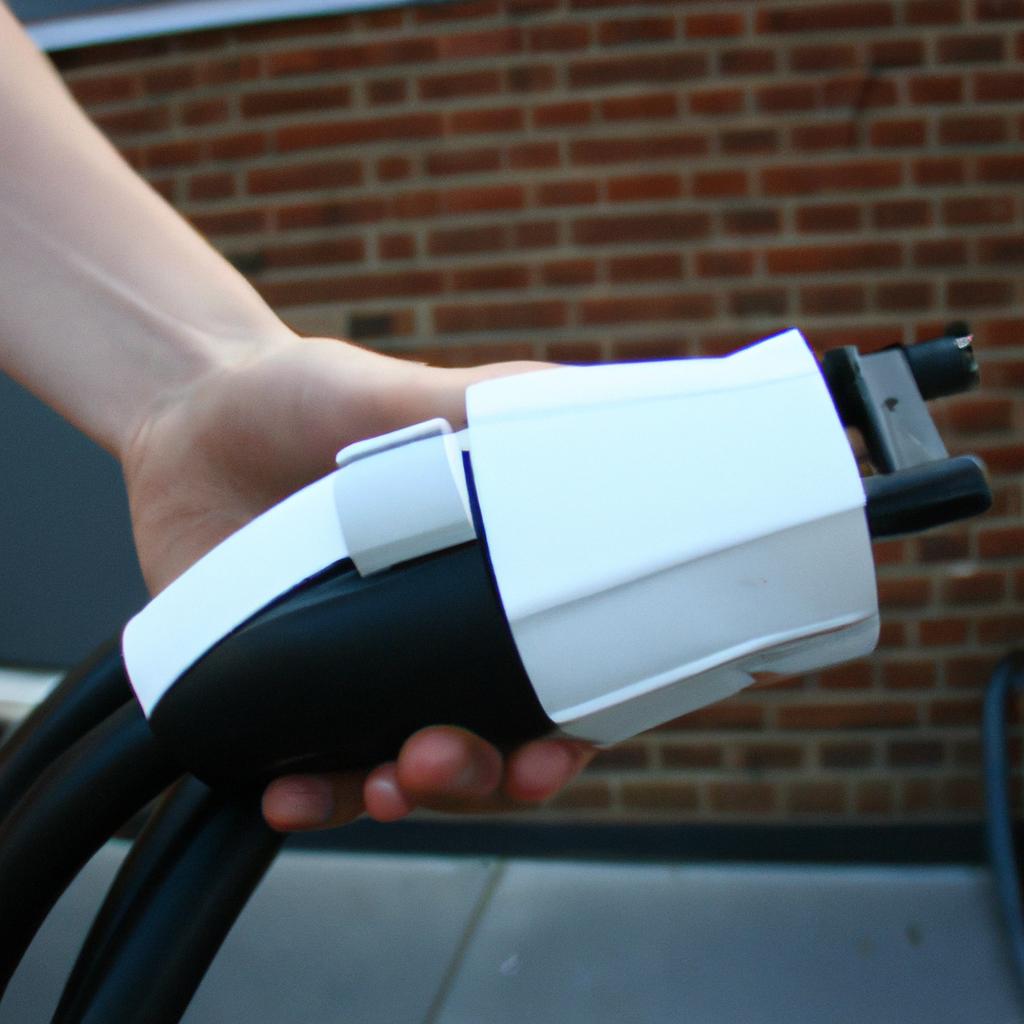Extreme weather conditions can have a significant impact on the range and performance of electric vehicles (EVs), leading to what is commonly known as “range anxiety.” Range anxiety refers to the fear or concern that an EV may not have enough battery power to reach its destination, especially in adverse weather conditions. For instance, imagine a scenario where an individual plans a long-distance trip with their EV during winter, only to find themselves stranded in the middle of nowhere due to poor range caused by freezing temperatures. This article aims to explore how different weather conditions such as extreme heat, cold, rain, and snow affect the range of EVs and contribute to range anxiety.
One of the key factors affecting EV range is temperature extremes. In hot climates, high temperatures can lead to accelerated battery degradation and increased energy consumption for cooling systems. On the other hand, frigid temperatures reduce battery efficiency and capacity while also increasing energy requirements for heating inside the vehicle. These effects are compounded by driving habits and patterns specific to each driver, making it crucial for individuals living in regions with extreme climates to consider these limitations when planning their journeys. By understanding how various weather conditions influence electric vehicle range, consumers can make informed decisions about their travel routes and charging strategies to mitigate range anxiety.
What are the factors affecting electric vehicle range?
Factors affecting electric vehicle range can vary depending on various factors, including weather conditions. Understanding these factors is crucial in addressing the issue of electric vehicle (EV) range anxiety and finding effective solutions.
To illustrate the impact of certain factors, consider a hypothetical scenario where two EVs are traveling under different circumstances. The first EV is driving in ideal weather conditions, with moderate temperatures and no significant wind or precipitation. In contrast, the second EV is facing adverse weather conditions such as extreme cold temperatures and heavy rain.
Several key factors influence the range of an electric vehicle:
- Battery Capacity: The capacity of an EV’s battery directly affects its range. Higher-capacity batteries generally provide longer ranges before requiring recharging.
- Driving Style: Aggressive acceleration, frequent braking, and high speeds can significantly reduce the efficiency and overall range of an electric vehicle.
- Terrain: Uphill drives require more energy to overcome gravity, resulting in reduced mileage compared to flat roads.
- Weather Conditions: Extreme temperature variations, strong winds, and heavy precipitation all affect an EV’s performance and decrease its range.
Consider this bullet point list highlighting some effects of weather conditions on electric vehicle range:
- Cold temperatures increase battery resistance, reducing overall efficiency and decreasing range.
- Hot temperatures can cause increased power demand for air conditioning systems, impacting available energy for driving.
- Strong winds create aerodynamic drag that requires additional power from the battery to maintain speed.
- Heavy rain or snow can lead to slippery road conditions which may necessitate lower speeds or increased use of heating systems.
Additionally, information regarding how specific weather conditions impact electric vehicle range can be summarized in a table format:
| Weather Condition | Effect on Range |
|---|---|
| Cold Temperatures | Decreased battery efficiency |
| Hot Temperatures | Increased power demand for air conditioning |
| Strong Winds | Additional power required due to drag |
| Heavy Rain/Snow | Lower speeds or increased heating demand |
Understanding the factors affecting electric vehicle range, including weather conditions, is essential for addressing concerns related to EV range anxiety. In the subsequent section, we will delve further into how weather conditions impact electric vehicle range and explore potential solutions to mitigate these effects.
How does weather conditions impact electric vehicle range?
Factors Affecting Electric Vehicle Range
In the previous section, we discussed various factors that can impact the range of electric vehicles. Now, let us delve deeper into one specific factor that plays a significant role in determining an electric vehicle’s range: weather conditions.
Imagine this scenario: Sarah is planning a long road trip with her electric vehicle from Chicago to Denver. She carefully considers all the factors affecting her car’s range and estimates that she will be able to complete the journey comfortably on a single charge. However, as she embarks on her adventure, she realizes that extreme weather conditions are negatively impacting her car’s range. This situation highlights the crucial influence of weather conditions on electric vehicles’ performance.
Weather Conditions and Electric Vehicle Range:
- Temperature Extremes: Extreme temperatures, both hot and cold, adversely affect an electric vehicle’s battery capacity and overall efficiency.
- Wind Resistance: Strong headwinds or crosswinds increase aerodynamic drag, requiring more energy to overcome resistance and reducing the vehicle’s effective range.
- Precipitation: Rainfall or snow accumulation affects tire traction and increases rolling resistance, resulting in reduced efficiency and decreased range.
- Humidity: High humidity levels may lead to increased air density, making it harder for an electric vehicle to move through the atmosphere efficiently.
To emphasize these impacts further:
| Weather Condition | Impact |
|---|---|
| Extremely Hot | Decreased battery performance due to increased internal resistance caused by high temperature. |
| Extremely Cold | Reduced battery capacity and increased power requirements for heating purposes. |
| Heavy Rain | Increased rolling resistance reduces efficiency and decreases driving distance per charge. |
| Snow | Lowered traction demands higher energy consumption while overcoming slippage. |
Considering these implications, it becomes evident why many electric vehicle owners experience range anxiety during extreme weather conditions; their cars simply cannot perform optimally under such circumstances.
Looking ahead, our next section will explore the specific reasons behind electric vehicles’ reduced range in extreme temperatures. By understanding these factors, we can gain further insights into how to mitigate range anxiety and enhance the overall performance of electric vehicles.
[Transition sentence: In the subsequent section, we will delve into why electric vehicles have reduced range in extreme temperatures.]Why do electric vehicles have reduced range in extreme temperatures?
Weather Conditions and Electric Vehicle Range Anxiety
Extreme temperatures, whether hot or cold, can significantly affect the range of electric vehicles (EVs). To illustrate the impact, let us consider a hypothetical scenario where an EV owner named Sarah plans to drive from her home in California to visit family in Minnesota during winter. In California’s mild climate, she typically achieves a range of 200 miles on a full charge. However, as Sarah ventures into colder regions with freezing temperatures, she notices that her EV’s range decreases considerably.
Several factors contribute to this reduction in range:
- Battery Efficiency: Cold weather negatively affects battery efficiency by increasing its internal resistance. As a result, it takes more energy to power the same distance compared to warmer conditions. This decrease in efficiency directly impacts the overall driving range of the EV.
- Increased Energy Demand: Heating systems are necessary to keep occupants warm inside the car when it is cold outside. These heating systems draw additional electrical energy from the battery, further reducing the available range for driving.
- Tire Pressure: Cold weather causes tire pressure to drop, which increases rolling resistance and reduces fuel efficiency. Similarly, lower tire grip due to icy or snowy roads requires extra energy for propulsion.
- Regenerative Braking Efficiency: Regenerative braking allows EVs to recover some kinetic energy while decelerating or stopping by converting it back into usable electricity stored in the battery. However, extremely low temperatures can reduce regenerative braking efficiency, resulting in less energy being recovered and thus affecting overall range.
To better understand how these factors impact an EV’s range under different temperature conditions, we can refer to the following table:
| Temperature | Estimated Range Reduction |
|---|---|
| Mild | None |
| Cool | Up to 10% |
| Freezing | Up to 40% |
| Extreme | Up to 50% |
This table highlights the significant range reduction that can occur as temperatures drop. It is evident that EV owners may face a considerable decrease in their driving range, leading to what is commonly referred to as “range anxiety” – the fear of running out of battery power during a journey.
In light of these challenges, it becomes crucial to explore strategies and technologies that mitigate the impact of weather on electric vehicle range. The subsequent section will delve into possible solutions for reducing this range anxiety and ensuring optimal performance regardless of weather conditions.
What can be done to mitigate the impact of weather on electric vehicle range?
Section H2: Mitigating the Impact of Weather on Electric Vehicle Range
To illustrate the importance of addressing weather-related range limitations, let us consider a hypothetical scenario. Imagine a family embarking on a road trip in their electric vehicle during winter. As they traverse through regions with sub-zero temperatures and heavy snowfall, they find their vehicle’s range significantly reduced due to the extreme weather conditions. This experience highlights the need for effective strategies to mitigate the impact of weather on electric vehicle range.
There are several measures that can be taken to alleviate weather-related range anxiety:
-
Improving battery thermal management systems: Extreme temperatures can adversely affect battery performance, leading to reduced range. Implementing advanced thermal management systems helps maintain optimal operating temperatures for batteries, mitigating the negative effects of cold or hot weather.
-
Enhancing regenerative braking systems: Regenerative braking is an energy recovery mechanism used in electric vehicles that converts kinetic energy into electrical energy during deceleration or braking. By improving this system’s efficiency, more energy can be captured and stored back into the battery, compensating for any losses caused by adverse weather conditions.
-
Optimizing heating and cooling mechanisms: Heating and cooling within electric vehicles consume significant amounts of energy, impacting overall range. Developing efficient climate control systems that minimize power consumption while ensuring passenger comfort will help extend electric vehicle range in all weather conditions.
-
Utilizing predictive analytics and navigation systems: Incorporating real-time data from weather forecasts and road conditions into onboard computers allows electric vehicles to optimize route planning based on anticipated temperature extremes or other adverse factors. This facilitates pre-emptive actions such as adjusting driving speed or finding alternative charging stations along the way.
The emotional impact stemming from these challenges is evident when considering a comparison between conventional gasoline-powered vehicles and electric vehicles subjected to extreme temperatures:
| Conventional Gasoline Vehicles | Electric Vehicles | |
|---|---|---|
| Fuel Efficiency | Typically unaffected by weather conditions. | Range can be significantly reduced in extreme heat or cold. |
| Environmental Impact | Emissions contribute to air pollution and climate change. | Zero tailpipe emissions, reducing environmental impact. |
| Cost of Operation | Dependent on fluctuating gasoline prices. | Lower operating costs due to cheaper electricity rates. |
| Energy Independence | Reliant on fossil fuel availability and geopolitical factors. | Reduced dependence on foreign oil, promoting energy independence. |
In summary, mitigating the impact of weather on electric vehicle range requires a multi-faceted approach involving improvements in battery thermal management systems, regenerative braking efficiency, heating/cooling mechanisms, as well as predictive analytics and navigation integration. By implementing these strategies, we can address range anxiety caused by adverse weather conditions and enhance the overall viability and appeal of electric vehicles.
Are there any technological advancements addressing weather-related range limitations? Let us explore this question further in the subsequent section.
Are there any technological advancements addressing weather-related range limitations?
Mitigating the Impact of Weather on Electric Vehicle Range
Example: Let us consider a hypothetical scenario where an electric vehicle owner, James, resides in a region with extreme cold temperatures during winter. He has noticed that his electric vehicle’s range significantly decreases when driving in such weather conditions. To address this issue and alleviate range anxiety caused by adverse weather, several measures can be implemented.
Firstly, optimizing battery management systems can help mitigate the impact of weather on electric vehicle range. Advanced technology allows for improved thermal management, ensuring batteries are kept at optimal operating temperature regardless of external conditions. This helps to maintain battery efficiency and extend overall range. Companies like Tesla have pioneered active liquid heating and cooling systems to regulate battery temperature effectively.
Secondly, enhancing aerodynamics can contribute to increased energy efficiency and extended range. Design modifications such as reducing drag coefficient through streamlined body shapes or adding features like automatic grille shutters can improve airflow around the vehicle. This reduces resistance against wind, ultimately conserving energy consumption during travel.
Thirdly, advancements in tire technologies offer potential solutions for mitigating weather-related range limitations. The development of low rolling resistance tires specifically designed for electric vehicles aids in minimizing friction between tires and road surfaces. Additionally, some manufacturers integrate smart tire pressure monitoring systems that provide real-time feedback on tire condition and optimize performance accordingly.
Lastly, employing predictive analytics based on weather forecasts can assist drivers in planning their journeys more efficiently. By utilizing data from local meteorological agencies or integrated onboard systems connected to the internet, drivers can gain insights into upcoming weather patterns affecting their routes. This information enables them to adjust driving strategies beforehand to maximize electric vehicle range under various weather conditions.
- Reducing drag coefficient through aerodynamic design
- Optimizing battery thermal management systems
- Utilizing low rolling resistance tires
- Implementing predictive analytics based on weather forecasts
Markdown table:
| Advantages | Challenges | Opportunities |
|---|---|---|
| Increased energy efficiency | High initial costs | Technological advancements |
| Extended electric vehicle range | Limited availability of certain technologies | Collaboration between manufacturers and researchers |
| Enhanced driving experience | Recycling and disposal of old components | Consumer education and awareness |
In conclusion, mitigating the impact of weather on electric vehicle range can be achieved through various measures such as optimizing battery management systems, enhancing aerodynamics, leveraging tire technology advancements, and utilizing predictive analytics. These strategies offer potential solutions to address range limitations caused by adverse weather conditions. However, further research and development are necessary to overcome challenges associated with cost-effectiveness and technological limitations.
Moving forward, it is essential for drivers to understand how they can effectively manage their electric vehicle range in different weather conditions. Thus, the next section will explore practical tips for maximizing electric vehicle range under varying weather scenarios.
How can drivers effectively manage their electric vehicle range in different weather conditions?
Technological advancements have played a crucial role in addressing weather-related range limitations for electric vehicles (EVs). This section explores some of the key developments that aim to alleviate EV range anxiety caused by adverse weather conditions.
One example of such technological advancement is the use of regenerative braking systems. These systems allow EVs to capture and store energy generated during deceleration or braking, which can then be utilized to power the vehicle during acceleration or when additional power is needed. By effectively harnessing this energy, regenerative braking systems help mitigate the impact of cold temperatures on battery performance, thus extending the overall driving range.
In addition to regenerative braking systems, several other measures have been introduced to improve EV performance in different weather conditions:
- Battery thermal management: Advanced thermal management systems regulate the temperature of the battery pack, ensuring optimal operating conditions regardless of external temperatures. By maintaining an ideal temperature range, these systems enhance both charging efficiency and overall driving range.
- Improved aerodynamics: Streamlined designs and improved airflow management reduce drag on EVs, enhancing their efficiency. This allows them to overcome increased air resistance caused by strong winds or extreme weather conditions.
- Energy-efficient climate control: Innovative HVAC (Heating, Ventilation, and Air Conditioning) technologies enable efficient cabin heating and cooling without significant impacts on driving range. Systems like heat pumps utilize waste heat from various sources within the vehicle to warm up the cabin, reducing reliance on battery power.
These advancements are vital in mitigating weather-related challenges faced by EV owners. The table below provides a summary comparison between conventional internal combustion engine vehicles (ICEVs) and electric vehicles (EVs), highlighting how certain features affect their performance in varying weather conditions:
| Factors | ICEVs | EVs |
|---|---|---|
| Cold Weather | May experience reduced | Efficient thermal management |
| battery performance | system regulates battery temperature | |
| due to increased | for optimal performance. | |
| viscosity of fluids | ||
| ———————– | ————————- | ————————————– |
| Hot Weather | Cooling systems may be | Energy-efficient climate control |
| required, but without | technologies ensure cabin comfort | |
| significant impacts on | while minimizing range reduction. | |
| overall performance | ||
| ———————– | ————————- | ————————————– |
| Windy Conditions | Minimal impact | Improved aerodynamics reduce drag |
| and maintain efficiency. |
This comparison highlights how EVs have made advancements specifically geared towards addressing weather-related range limitations, making them a viable option for drivers in various climates.
In summary, technological advancements such as regenerative braking systems, battery thermal management, improved aerodynamics, and energy-efficient climate control are helping to alleviate concerns regarding electric vehicle range limitations caused by adverse weather conditions. These developments enable EVs to perform optimally in different climates, reducing range anxiety and providing greater peace of mind to drivers.
 Sfeva
Sfeva



